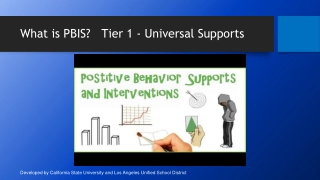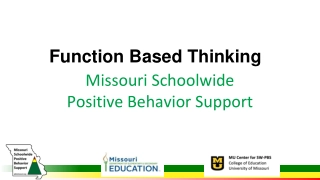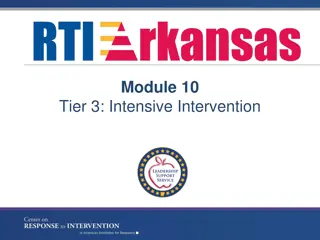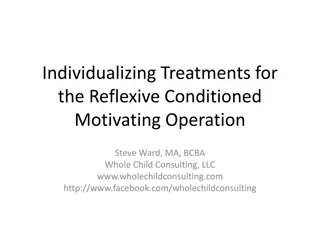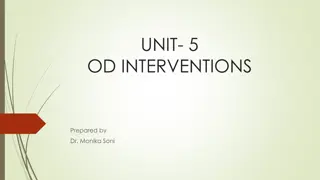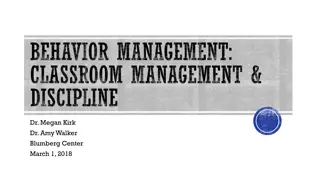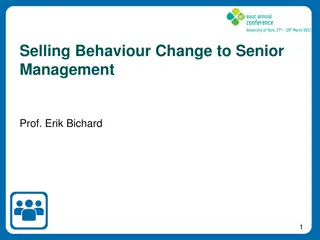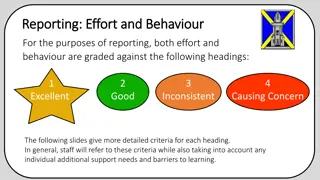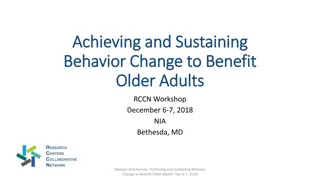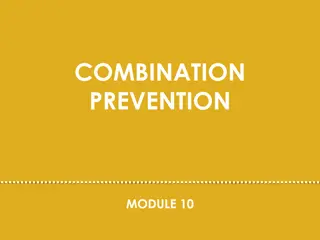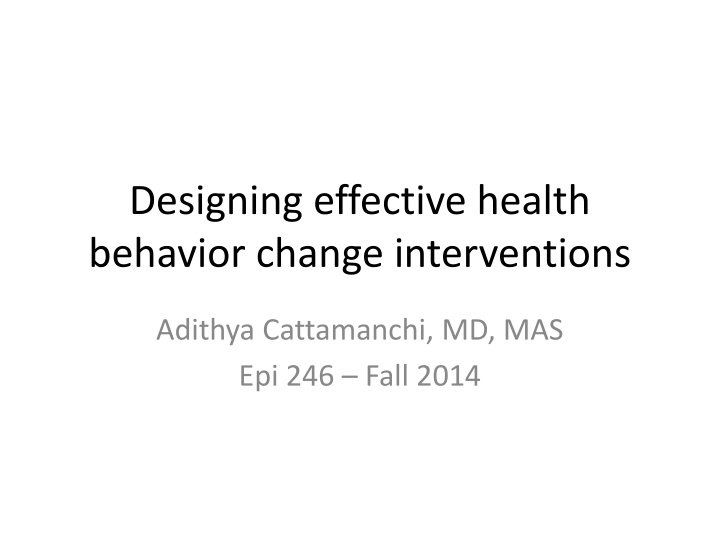
Effective Health Behavior Change Interventions: Closing the Evidence-Practice Gap
Learn about the importance of closing the evidence-practice gap in healthcare to optimize patient care, outcomes, and costs. Explore the traditional and behavioral approaches to evidence translation, along with planning models and key steps for designing effective behavior change interventions.
Uploaded on | 0 Views
Download Presentation

Please find below an Image/Link to download the presentation.
The content on the website is provided AS IS for your information and personal use only. It may not be sold, licensed, or shared on other websites without obtaining consent from the author. If you encounter any issues during the download, it is possible that the publisher has removed the file from their server.
You are allowed to download the files provided on this website for personal or commercial use, subject to the condition that they are used lawfully. All files are the property of their respective owners.
The content on the website is provided AS IS for your information and personal use only. It may not be sold, licensed, or shared on other websites without obtaining consent from the author.
E N D
Presentation Transcript
Designing effective health behavior change interventions Adithya Cattamanchi, MD, MAS Epi 246 Fall 2014
The evidence-practice gap Consistent failure to translate evidence into routine practice 50% of patients do not receive recommended care 30% of medical spending is on unnecessary care Closing evidence-practice gap critical to optimizing patient care, outcomes and costs Asch SM. NEJM 2006; Dartmouth Atlas of Healthcare
Traditional approach to evidence translation It Seemed Like A Good Idea At The Time ISLAGIATT Principle Martin Eccles
Behavioral approach to evidence translation Implementation depends on stakeholder behavior Improving care requires changing behavior Changing behavior requires understanding determinants of current behavior and how behavior changes
Logic Model Behavioral Factors / Behavioral Risk Personal Determinants Health Problems Environmental Factors / Environmental Risk Contextual Determinants Societal Community Organizational Interpersonal ADAPTED FROM: Green and Kreuter
Steps in Planned Health Promotion Step 1: Analysis of health and quality of life Step 2: Analysis of behavioral/environmental risk factors Step 3: Analysis of determinants of risk Step 4: Design of intervention that targets key determinants Step 5: Evaluation of intervention
Planning models/frameworks Step-by-step guide for intervention development and evaluation Incorporate use of theory Define problem Design intervention Evaluate intervention
Objectives Understand planning models useful for designing effective behavior change interventions Behavior Change Wheel PRECEDE-PROCEED Intervention Mapping Understand key steps involved in designing effective behavior change interventions Understand the role and use of behavioral theory
Behavior Change Wheel Synthesis of 19 behavior change frameworks None were comprehensive Few conceptually coherent Few linked to a general theory of behavior change Proposed advantages of BCW Incorporates common features of prior frameworks Identifies concrete and distinct intervention functions to guide design Linked to a behavior change theory that can be applied in any setting Michie S. Imp Sci 2011
Using the BCW Stage 1: Understand the behavior Stage 2: Identify intervention options Stage 2: Identify content and implementation options Select: 7. Behavior change techniques 8. Mode of delivery 1. Define the problem in behavioral terms 2. Select target behavior(s) 3. Specify the target behavior(s) 4. Identify what needs to change Select: 5. Intervention functions 6. Policy categories Remaining slide content adapted from: 1. Michie S et al. The BCW A Guide to Designing Interventions. Silverback Publishing. 2014. 2. Michie S. The Behaviour Change Wheel: a method for designing effective interventions. Implementation Science Summer School, Dublin 2012
Step 1 Define the problem in behavioral terms State key specific behaviors needed to achieve the health outcome of interest EXAMPLE Problem: High infection rates in hospitals Specific behaviors involved: Cleansing hands with alcohol rub (hand hygiene) Using protective clothing Cleaning/disinfecting surfaces Maintaining proper isolation
Step 2 Select target behaviors Nurse Hand Hygiene Behavior Hospital staff ensuring availability of gel in dispensers Senior doctors hand hygiene behavior Patients asking if they washed their hands Criteria for selecting target behaviors Likely impact if behavior changed How easy is it likely to be to change the behavior Centrality of the behavior (likelihood of positive spillover effects on other behaviors) Ease of measurement
Step 3 Specify the target behavior(s) Who needs to do what differently, when, where, how, with whom? Target behavior Clean hands using alcohol gel Who? Nurses When/How often? Start of each shift After using bathroom Every time before entering patient room Every time after exiting patient room Where? Hospital Wards How? Rinse with alcohol gel and air dry With whom? Alone
Step 4 Identify what needs to change Psychological or physical ability to enact the behavior Capability Reflective or autonomic mechanisms that activate or inhibit the behavior Motivation Behavior Physical and social environment that enables the behavior Opportunity Michie S. Imp Sci 2011
COM-B Components COM-B Model Component Example Physical Capability Having the physical stamina to go running Psychological Capability Knowledge of the health benefits of cardiovascular activity Physical Opportunity Being able to go running because one owns appropriate shoes Social Opportunity Being able to go running because there is a neighborhood running group Reflective Motivation Belief that running is good for health Automatic Motivation Feeling anticipated pleasure from the high associated with running
COM-B vs. other theories Cognitive : Psychological capability Env: Physical and social opportunity Behavioral: Physical and psychological capability Attitude: Psychological capability, Reflexive Motivation Norms: Social opportunity Control: Psychological capability
How to identify what needs to change Collect data from as many relevant sources ( stakeholders ) as possible Use variety of methods Literature review; Records review; Protocol review; Interviews/focus groups; Direct observation Triangulate information from different sources/methods
COM-B Diagnosis: Hand hygiene example COM-B Component What needs to happen for target behavior to occur? Is there a need for change? Capability Physical Have physical skills to clean hands No staff already have these skills Capability Psychological Know correct technique to clean hands No knowledge is sufficient Opportunity Physical Have alcohol gel available No alcohol gel available consistently Opportunity Social See senior doctors clean their hands Yes doctors are terrible at cleansing hands Motivation Reflexive Believe that hand hygiene will require improved cognitive and self- regulation skills Yes staff do not recognize the value of these skills Motivation Autonomic Have established routines and habits for hand cleansing Yes change needed to establish habits Behavioral Diagnosis: Social opportunity, Reflexive motivation and autonomic motivation need to change in order for target behavior to occur
Small Group Exercise Complete BCW Worksheet 3 (Specify target behavior Complete BCW Worksheet 4: COM-B Diagnosis) or consider how you will collect data
Using the BCW Stage 1: Understand the behavior Stage 2: Identify intervention options Stage 2: Identify content and implementation options Identify: 7. Behavior change techniques 8. Mode of delivery 1. Define the problem in behavioral terms 2. Select target behavior(s) 3. Specify the target behavior(s) 4. Identify what needs to change Identify: 5. Intervention functions 6. Policy categories
Step 5 Identify intervention functions BCW links COM-B diagnosis to intervention functions Intervention function = Broad categories of means by which an intervention can change behavior
Intervention functions: Hand hygiene example COM-B Diagnosis Intervention Function Social Opportunity -- Do not see senior doctors clean their hands Restriction Environmental restructuring Modeling Enablement Reflexive Motivation -- Do not believe that hand hygiene will require improved cognitive and self- regulation skills Education Persuasion Modeling Enablement Autonomic Motivation -- Do not have established routines and habits for hand cleansing Training Incentivisation Coercion Environmental restructuring
Step 6 Identify policy categories Types of decisions made by authorities that help to support and enact the interventions BCW synthesis of 19 frameworks Identified seven distinct policy categories Suggested which policy categories effective in supporting different intervention functions
Selecting policy categories Requires judgment Use evidence where available APEASE criteria Affordability Practicality Effectiveness/cost-effectiveness Acceptability Side-effects/safety Equity
Policy categories: Hand hygiene example Intervention Function Potential Policy Categories APEASE Criteria Incentivisation Communications/marketing Yes Guidelines No already exist Fiscal Measures No not practical Regulation Not in short-term Legislation No not practical Service Provision Yes Enablement Guidelines No already exist Fiscal Measures No not practical Regulation Not in short-term Legislation No not practical Service Provision Yes Environmental/social planning No - not practical
Using the BCW Stage 1: Understand the behavior Stage 2: Identify intervention options Stage 2: Identify content and implementation options Identify: 7. Behavior change techniques 8. Mode of delivery 1. Define the problem in behavioral terms 2. Select target behavior(s) 3. Specify the target behavior(s) 4. Identify what needs to change Identify: 5. Intervention functions 6. Policy categories
Step 7 Identify behavior change techniques Goal: Translate intervention functions into specific techniques to change behavior BCT: An active component of an intervention designed to change behavior Active component = Observable, Replicable, Irreducible Systematic review used to develop a BCT taxonomy 93 distinct BCTs grouped into 16 categories BCTs appropriate for each of the 9 intervention functions (as judged by 4 experts) identified
BCT Taxonomy Example No. Label Definition Example 1. Goals and Planning 1.1 Goal setting (behavior) Set or agree on a goal defined in terms of the behavior to be achieved Agree on a dialy walking goal (e.g., 3 miles) and reach agreement about the goal Set the goal of eating 5 pieces of fruit per day
The BCT Taxonomy Resources http://www.bct-taxonomy.com/ Criteria for selecting BCTs Start with list of BCTs appropriate for the selected intervention function Narrow list of possible BCTs Use APEASE criteria Stakeholder consultation Consider BCTs used more vs. less frequently BCTTv1 App
Identify BCT(s) Hand Hygiene Example COM-B component Intervention function Policy Category BCT Reflexive Motivation Autonomic Motivation Incentivization Service Provision 1. Feedback on behavior 2. Non-specific reward Social Opportunity Autonomic Motivation Enablement 3. Goal setting (behavior) Summary: Deliver selected BCTs through changes in service provision to incentivize and enable nurses to cleanse their hands with alcohol gel
Step 8 Identify Mode of Delivery BCT reflects intervention content Mode of delivery reflects how BCT is put in place Bottom line: Consider full range of options and then select based on stakeholder consultation, APEASE criteria
Identify Modes of Delivery Hand Hygiene Example COM-B component Intervention function Policy Category BCT Reflexive Motivation Autonomic Motivation Incentivisation Service Provision 1. Feedback on behavior Ward coordinator observed nurses individually and provided feedback in group meetings on % hand washing Social Opportunity Autonomic Motivation Enablement 2. Non-specific reward If compliance 100%, certificate given and noted at annual appraisal 3. Goal setting (behavior) If <100% compliance, goal set and agreed upon with ward coordinator
BCW Summary Stage 1: Understand the behavior Stage 2: Identify intervention options Stage 2: Identify content and implementation options Identify: 7. Behavior change techniques 8. Mode of delivery 1. Define the problem in behavioral terms 2. Select target behavior(s) 3. Specify the target behavior(s) 4. Identify what needs to change Identify: 5. Intervention functions 6. Policy categories Step-by-step guide to intervention design Linked to a generally applicable theory of behavior A focus on identifying and addressing mechanism of action (i.e., behavioral determinants)
PRECEDE-PROCEED Phase 2 Phase 3 Educational & ecological assessment Phase 1 Social assessment Phase 4a Intervention Alignment Epidemiological, Behavioral and Environmental Assessment Planning tasks (PRECEDE): Specifying measurable objectives and baselines. Predisposing Health Program Genetics Phase 4b Administrative & Policy Assessment Educational strategies Reinforcing Behavior Health Quality of life Policy regulation organization Environment Enabling Evaluation Tasks (PROCEED): Monitoring & Continuous Quality Improvement Short-term impact Longer-term health outcome Short-term social impact Long-term social impact Input Process Output Phase 5 Phase 6 Phases 7-8 Implementation Process evaluation Impact and outcome evaluation
Intervention Mapping

